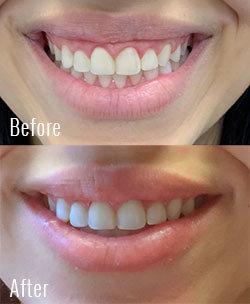
Have you ever noticed that when you smile, your gums show a little too much? It’s what some people refer to as a “gummy smile.” But what exactly is a gummy smile and how can it be treated? In this article, we’ll dive into the world of gummy smiles, exploring what they are, what causes them, and the various treatment options available. So, if you’re curious about gummy smiles and how to address them, keep reading!
A gummy smile, also known as excessive gingival display, occurs when a significant portion of your gums is visible when you smile. Instead of just showcasing your pearly whites, your gums take center stage and steal the show. While it’s completely natural for a small part of your gums to show when you smile, some individuals may feel self-conscious or unhappy with the amount of gum tissue that’s on display. Luckily, there are several treatment options to help you achieve a smile that you’re more comfortable and confident with. From dental procedures to orthodontic treatments, we’ll explore the various methods that can help you overcome the challenges of a gummy smile. So, let’s jump right in and discover how to tackle this common dental concern!
Gummy Smile: What It Is and How to Treat It
A gummy smile is a condition where excessive gum tissue is visible when a person smiles. While it doesn’t pose any health risks, many people feel self-conscious about it. Fortunately, there are several treatment options available. One common method is Botox injections, which can relax the muscles that elevate the upper lip, reducing gum exposure. Another option is crown lengthening surgery, where the excess gum tissue is removed to reveal more of the teeth. Consult with a qualified dentist or periodontist to determine the best course of action for your gummy smile.

Gummy Smile: What It Is and How to Treat It
A gummy smile is a term used to describe a smile in which a significant portion of the gums is visible above the teeth. While a gummy smile is not a medical concern, it can impact a person’s self-confidence and aesthetics. Many people with a gummy smile seek treatment options to improve their smile and achieve a more balanced and harmonious appearance.
There are several potential causes of a gummy smile. One common cause is excessive gum tissue, which can make the teeth appear shorter and the gums more prominent. Another cause may be the way the upper jaw bone developed, resulting in an excessive display of gum tissue when smiling. Additionally, certain dental conditions or habits, such as a hyperactive upper lip or improper tooth eruption, can contribute to a gummy smile.
What Causes a Gummy Smile?
1. Excessive Gum Tissue
Excessive gum tissue, also known as gingival hypertrophy, can cause a gummy smile. This condition can be genetic, meaning it is inherited from one or both parents. In some cases, it may be caused by certain medications or hormonal changes. Excessive gum tissue can make the teeth look short and the gums appear more prominent.
2. Abnormal Jaw Development
Abnormal jaw development can also contribute to a gummy smile. If the upper jaw bone grows excessively or the upper lip is hyperactive, more gum tissue may be exposed when smiling. This can create an unbalanced aesthetic and make the teeth appear smaller.
Treatments for a Gummy Smile
1. Gum Contouring
Gum contouring, also known as gingivectomy or gum reshaping, is a common treatment option for a gummy smile. During this procedure, a periodontist or a dentist trims away excess gum tissue to reveal more of the tooth structure. This can create a more proportionate and balanced smile.
2. Orthodontic Treatment
Orthodontic treatment, such as braces or clear aligners, may be recommended for individuals with a gummy smile caused by abnormal jaw development or tooth eruption. By correcting the alignment of the teeth and jaws, orthodontic treatment can help improve the overall appearance of the smile and reduce the visibility of the gums.
3. Botox Injections
In some cases, a gummy smile may be caused by a hyperactive upper lip. Botox injections can be used to temporarily relax the muscles responsible for lifting the upper lip, reducing the amount of gum tissue exposed when smiling. This non-surgical treatment option can provide significant improvement for those with a gummy smile caused by muscle hyperactivity.
4. Crown Lengthening
Crown lengthening is a surgical procedure that involves removing excess gum tissue and, if necessary, a small portion of the underlying bone to expose more of the tooth structure. This can be an effective treatment option for individuals with a gummy smile caused by excessive gum tissue.
By addressing the underlying causes of a gummy smile, these treatment options can help individuals achieve a more confident and attractive smile. It is important to consult with a qualified dental professional to determine the most appropriate treatment plan based on the individual’s specific needs and goals.
Preventing a Gummy Smile
While some causes of a gummy smile are genetic or cannot be prevented, there are certain measures individuals can take to promote gum health and minimize the risk of developing a gummy smile. Regular dental check-ups and proper oral hygiene practices, such as brushing twice a day and flossing daily, can help maintain healthy gums and prevent gum-related issues.
In conclusion, a gummy smile is a common concern that can impact a person’s self-confidence and aesthetics. Fortunately, there are various treatment options available to address this issue and help individuals achieve a more balanced and harmonious smile. Whether through gum contouring, orthodontic treatment, Botox injections, or crown lengthening, individuals can find a solution that suits their specific needs and goals. Consulting with a qualified dental professional is essential to determine the most suitable treatment plan for each individual. Remember, a beautiful smile can enhance self-esteem and overall well-being.
Key Takeaways: Gummy Smile – What It Is and How to Treat It
- A gummy smile is when a large portion of the gums is visible when a person smiles.
- It can be caused by factors like excessive gum tissue, a short upper lip, or a hyperactive muscle.
- Treatment options for a gummy smile include gum contouring, Botox injections, and orthodontic treatment.
- Consulting with a dentist or orthodontist is crucial to determine the best treatment approach.
- Addressing a gummy smile can improve self-confidence and enhance the overall appearance of the smile.
Frequently Asked Questions
What causes a gummy smile?
A gummy smile, medically known as excessive gingival display, is caused by several factors. One common cause is excessive gum tissue, which can make the teeth appear shorter and the gums more prominent. Another cause can be an overactive upper lip muscle, which pulls the lip up higher than normal when smiling. Additionally, certain dental conditions such as an improper bite or jaw alignment issues can contribute to a gummy smile.
It’s important to consult with a dental professional to determine the exact cause of your gummy smile, as this will help guide the appropriate treatment plan.
How is a gummy smile treated?
Treatment options for a gummy smile depend on the underlying cause. If the excessive gum tissue is the main issue, a procedure called gum contouring or gum reshaping may be recommended. This involves removing or reshaping the excess gum tissue to create a more balanced smile. Laser therapy is often used for this procedure, as it provides precise and minimally invasive results.
In cases where an overactive upper lip muscle is the cause, Botox injections may be used to relax the muscle and reduce the amount of gum tissue exposed when smiling. Orthodontic treatment may also be necessary to address any underlying dental issues, such as an improper bite or jaw alignment.
Is gum contouring a painful procedure?
Gum contouring is generally a well-tolerated procedure with minimal discomfort. Before the procedure, a local anesthetic is administered to numb the gums, ensuring a painless experience. In some cases, sedation dentistry techniques may be used to help patients relax during the procedure. After the treatment, over-the-counter pain medications can help manage any post-procedure discomfort.
It’s important to follow the post-operative instructions provided by your dentist, which may include avoiding certain foods or activities for a few days to promote proper healing.
Are the results of gummy smile treatment permanent?
The results of gummy smile treatment can be long-lasting, but it’s important to note that individual factors can influence the longevity of the results. For example, if the underlying cause of the gummy smile is due to an overactive upper lip muscle, the effects of Botox injections may gradually wear off over time and require maintenance treatments.
However, gum contouring procedures can provide lasting results as long as proper oral hygiene is maintained and regular dental check-ups are scheduled. It’s also important to address any underlying dental issues to ensure the stability of the results.
Can a gummy smile affect oral health?
While a gummy smile is primarily a cosmetic concern, it can have an impact on oral health in some cases. Excessive gum tissue can make it difficult to properly clean the teeth and gums, increasing the risk of plaque buildup and gum disease. Additionally, an improper bite or jaw alignment can lead to issues such as teeth grinding or temporomandibular joint (TMJ) disorders.
By addressing the underlying causes of a gummy smile and seeking appropriate treatment, potential oral health complications can be minimized, promoting a healthier smile overall.
3 Options to Treat a Gummy Smile: Doctors Advice
Final Summary: Understanding and Treating the Gummy Smile
Call or Book appointment online
:Ace Dental Care Alpharetta office: 678-562-1555 - Book Now
Ace Dental Care Norcross office: 770-806-1255 - Book Now
Disclaimer
This blog post was generated by artificial intelligence. The content of this post may not be accurate or complete, and should not be relied upon as a substitute for professional advice. If you have any questions about the content of this post, please contact us.
We are constantly working to improve the accuracy and quality of our AI-generated content. However, there may still be errors or inaccuracies. We apologize for any inconvenience this may cause.





